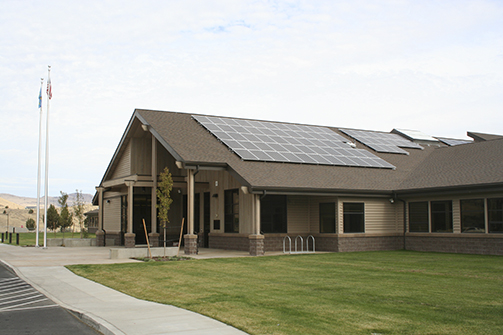Unique collaboration sees $21.6 million school built on tribal lands in Central Oregon. A long-cherished vision of educational opportunity for Confederated Tribes of Warm Springs students has come to fruition with the completion of a state-of-the-art $21.6 million K-8 school on tribal lands.
The new 80,000 square foot Warm Springs Academy features modern science and computer labs – supporting a technology-rich curriculum – together with art and music rooms, a spacious gymnasium and gathering spaces including a community room accessible for public use, and various cultural references dotted throughout recognizing the tribal community’s rich heritage and traditions.
The airy new contemporary style facility replaces the dilapidated cluster of aging buildings, some of which dated back over 80 years, and modular structures that was previously the base for elementary education off Highway 26, and the project was achieved through a unique collaboration between the tribal government and Jefferson School District.
Jefferson School District Director of Operations Darryl Smith said: “The school used to be in an old collection of buildings, including a main building constructed in the 1930’s and a gym originally built around 1910 before part of it subsequently burned down and was replaced.
“As the student population grew, modular ‘temporary’ buildings were put in place from 1976 through the 1980’s and early 90’s, and students also had to walk across the street to a cafeteria which lacked bathroom facilities.
“The same cramped campus area also housed mental health services and the public defender’s office, so it really was not an ideal situation.
“Post fifth-grade, students also previously had to deal with a lengthy early morning bus ride to attend middle school in Madras and back.”
Smith said talk about bringing higher grade education locally under one roof had been ongoing for decades, with funds being set aside on several occasions to catalyze discussions, but efforts sputtered as a series of false starts were experienced over the last 30 years for lack of finalized agreements.
The seeming breakthrough came after a major portion of the funds needed for the project was proposed in a Jefferson County bond measure – which also allocated backing for the Madras Performing Arts Center and High School stadium improvements – which successfully passed in 2012.
Smith said: “Part of the thinking was that with some other expiring obligations there was an opportunity through the bond vehicle to keep taxes at roughly the same level while enabling this project to get going.
“It was also important to address tribal leaders’ goals in wanting to regain access to, and have more control of, education locally.”
As part of the package, additional funding necessary to complete the project was achieved through Warm Springs residents and the US Department of Agriculture (USDA) Community Facilities loan program.
The new school, which was designed by BBT Architects and constructed by general contractor Kirby Nagelhout Construction Company, now houses around 650 students, with some 98 percent comprising tribal members
Project Architect Al Levage said: “The design for this school was developed into three, single story pods, with nine classrooms each around a collaboration space, catering to K-2, Grades 3-5 and 6-8.
“Throughout programming and initial design, budget was a constant consideration and a community-wide engagement process was utilized in the design.
“Working with two clients (Confederated Tribes of Warm Springs and Jefferson County School District) each with specific agendas, required intensive collaboration through the early programming and design phases of the project.
“Classrooms are clustered around break-out learning spaces with the pods stitched together by a common street. Learning spaces all have windows with views of Mt. Jefferson, the Palisades Cliffs and surrounding bluffs, or learning courtyards.
“With a fixed budget based on funding from three sources, the client’s desires were translated into feasible solutions that remained within budget. After initial design, a contractor was brought on board.
“Working closely with the client and the contractor, we incorporated changes to bring the project into budget while staying on a tight schedule.”
The design process included meetings with stakeholders such as community members, tribal elders and school staff, including a new principal.
KNCC Project Manager Jason Terry added: “One of our biggest challenges was the construction schedule. The team worked together during design to create an early site work bid package that gained the project about an extra month.
“But even with the early package the 14-month duration was short. The owner and architect teams worked very well to provide us with quick answers and the construction team worked diligently and creatively to complete this project on time.
“Other aspects of the project included sustainability features including a highly efficient VRV mechanical system that transfers warm or cool air between spaces to other spaces that are calling for heating or cooling, as opposed to traditional HVAC systems that simply heat or cool outside air as the spaces demand. In addition a large photovoltaic solar array was installed that offsets a good portion of the facility’s electrical demand.
“A commitment KNCC made and an expectation of the owners was that we would put tribal members to work on the project to the greatest extent possible. Our early goal was that twenty five percent of the labor, measured by man hours, would be tribal.
“This effort took a large level of outreach and training opportunities were provided to individuals who had a desire to work on the project. Man hours were tracked weekly and at the end of the day we met our goal.”
Smith added that part of the funds allocated for the project were aimed at promoting renewable energy, including the placing of the array of solar panels, installed by Sunlight Solar, on a south-facing roof, which were estimated to contribute up to twenty five percent of power needs.
Levage said sustainable features incorporated throughout brought the construction up to Leadership in Energy and Environmental Design (LEED) standards, including extensive use of glass and natural light.
He also observed that a strong community connection was reinforced by much use of local lumber and labor in the project, adding: “There was an emphasis on employing as many tribal members as possible, and at one time over fifty percent of the workforce on the project was made up of such Warm Springs residents.”
A spokesman for Wenaha Group, which acted as the construction management entity, said that a complex partnership arrangement, and the fact the project was jointly funded “required close coordination and cooperation between all parties”, adding: “The facility is a tribute to an all-round team effort and incorporates Tribal historical and cultural elements as well as accommodating uses not common to other school district facilities.”
Prominent references in the building include the school’s eagle mascot depicted in a hanging canvas, while sonic cut patterns inlaid in flooring pay homage to aesthetic traditions of the tribes.
A feature of the commons area is an artful flooring design illustrating the Columbia River and its tributaries, which have played such an important role in the lifeblood of the tribal region in Oregon and Washington.
A comprehensive security system is also in place, including centralized access and the ability to lock down and secure different sectors.
Smith also hailed the willingness and ability to employ many tribal members on the project. He said the school is also providing space to accommodate community counseling, resource officer and Health Services functions.
During extensive excavation, a cultural monitor also had to be on hand to ensure that no artifacts were unearthed or disturbed.
Smith added: “This project featured wonderful cooperation between team members and a respect for the unique needs involved in this undertaking.
“This included the contractor project manager being on site the whole time, and the superintendent considerately and efficiently coordinating building activities, as well as they being continuously accessible.”
Smith said the facility offers a new era of possibilities for students, bolstered by a fresh direction in instructional design, including a blended learning focus and new models of teaching balancing traditional instruction methods with self-paced digital lessons.
The academy also accommodates other modern teaching tools and techniques, including web-based resources to allow students to embrace a full and rich learning experience, and cutting edge audio visual equipment, including voice-enhancement technology which has been proving to reduce the number of teacher sick days.
Warm Springs K-8 Elementary School
50 Chukar Rd, Warm Spring, OR 97741
Contractor:
Kirby Nagelhout Construction
20635 Brinson Blvd.
Bend, OR 97701
541-389-7119
Project Cost: $18.1 million
Square Footage: 81,000
Financing: Mix of Warm Springs & USDA -50 percent
Jefferson County 509J – 50 percent
Project Manager: Jason Terry KNCC
Supervisor: Alec Hansen KNCC
Architect: BBT Architects Inc.
Principal Architect: Al Levage BBT Architects Inc.
Structural Engineer: Johnny Walker, Walker Engineer
Civil Engineer: WH Pacific
Mechanical Engineer: MFIA
Landscaping: Vallier Designs
Subcontractors and Suppliers:
Lets Construction, Latham Excavation, Taylor Northwest, 7 Peaks Paving, Beynon Sports Surfaces, Western Protective Coating, Warm Springs Construction, Shearer & Assoc., Mike’s Fence Center, Cedar Landscape, Ogden Construction, Insulation Contractors, AMJ-1 Roofing, Engineered Products A Pape Co., Bend Commercial Glass, Bell Hardware of Wilsonville, CCI Bend, CT Commercial, A-Game Courts, Dynamic Sports Construction, Fabulous Floors, Specialty Flooring & Tile, Northwest Handling Systems, Stagecraft Industries, Johnson Bros. TV & Appliance, Northwest Playground Equipment, Arizona Courtlines, Nor-Pac Seating, Wenger Corporation, OR Cascade Plumbing & Heating, Cascade Heating & Specialties, Tomco Electric, Miller Lumber and Sunlight Solar Energy Inc.





